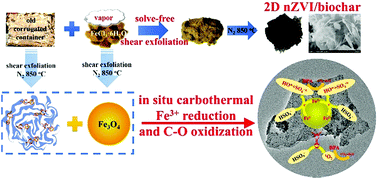Solvent-free synthesis of a 2D biochar stabilized nanoscale zerovalent iron composite for the oxidative degradation of organic pollutants†
Abstract
Nanoscale zerovalent iron (nZVI) and its composite materials have extensive applications in the field of environmental remediation. 3D nZVI/biochar composite materials have been prepared and reported, but the development of facile, environmentally friendly methods to produce 2D nZVI/biochar composites remains challenging. This study describes a facile solvent-free carbothermal redox approach to preparing graphene oxide-like 2D biochar stabilized nZVI with a shearing/carbonization method that uses lignocellulosic waste, old corrugated containers (OCCs), and FeCl3·6H2O as precursors. The association of a shear exfoliation/carbonization process with the deliquescence characteristic of FeCl3·6H2O and the catalysis of Fe3+ and Cl− resulted in the dispersion of Fe3+ phases into the OCC frameworks and the formation of an intrinsic graphene oxide-like 2D structure. In addition to the conventional carbothermal reduction of Fe species to nZVI by carbon, a simultaneous oxidation of the C–O groups inside the biochar to C![[double bond, length as m-dash]](https://www.rsc.org/images/entities/char_e001.gif) O groups, which could catalyze peroxymonosulfate (PMS) decomposition to generate 1O2, was also discovered. The as-synthesized 2D ZVI/biochar exhibited high catalytic activity and recyclability toward the degradation of bisphenol A (BPA) by activating either PMS or H2O2 under near-neutral pH conditions. The excellent catalytic activity of the as-synthesized ZVI/biochar can be ascribed to the synergetic effect of the Fe0 species, the ketonic C
O groups, which could catalyze peroxymonosulfate (PMS) decomposition to generate 1O2, was also discovered. The as-synthesized 2D ZVI/biochar exhibited high catalytic activity and recyclability toward the degradation of bisphenol A (BPA) by activating either PMS or H2O2 under near-neutral pH conditions. The excellent catalytic activity of the as-synthesized ZVI/biochar can be ascribed to the synergetic effect of the Fe0 species, the ketonic C![[double bond, length as m-dash]](https://www.rsc.org/images/entities/char_e001.gif) O groups, and the intrinsic graphene oxide-like 2D structure, which act as excellent electron transfer supports. The as-synthesized 2D nZVI/biochar exhibited excellent long-term stability without significant loss of activity after storage in air for 6 months. This study not only provides a simple, green solvent-free approach to the sustainable manufacture of graphene oxide-like biochar stabilized nZVI as a highly efficient and durable bi-functional catalyst, but also suggests new possibilities for the further design and fabrication of 2D nZVI composite materials.
O groups, and the intrinsic graphene oxide-like 2D structure, which act as excellent electron transfer supports. The as-synthesized 2D nZVI/biochar exhibited excellent long-term stability without significant loss of activity after storage in air for 6 months. This study not only provides a simple, green solvent-free approach to the sustainable manufacture of graphene oxide-like biochar stabilized nZVI as a highly efficient and durable bi-functional catalyst, but also suggests new possibilities for the further design and fabrication of 2D nZVI composite materials.



 Please wait while we load your content...
Please wait while we load your content...